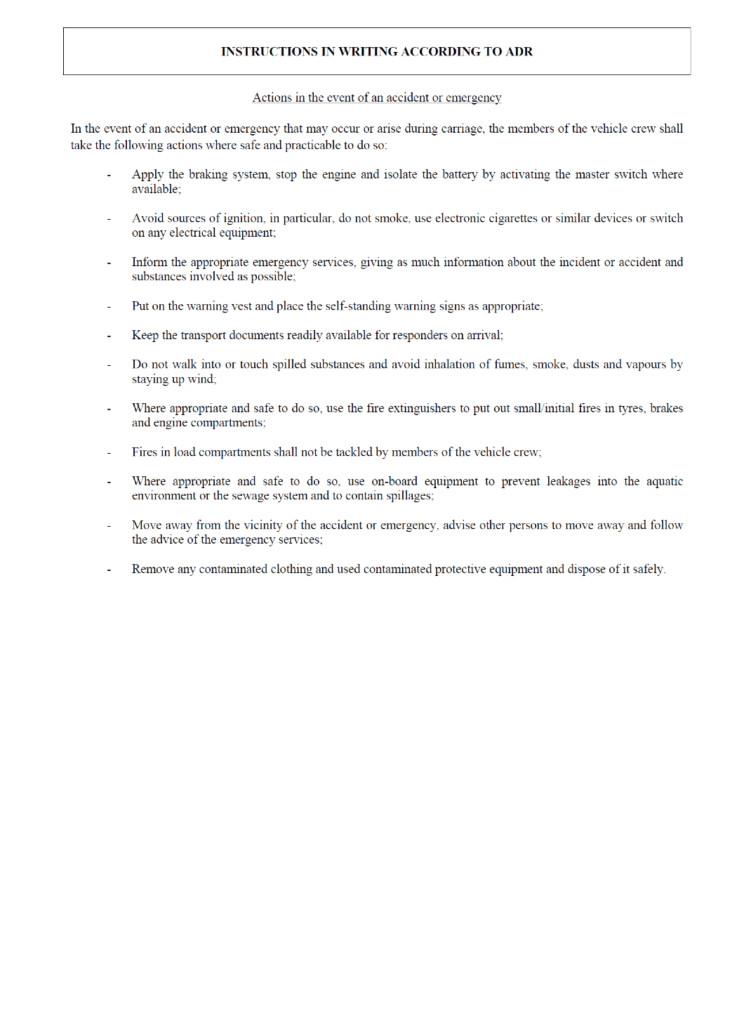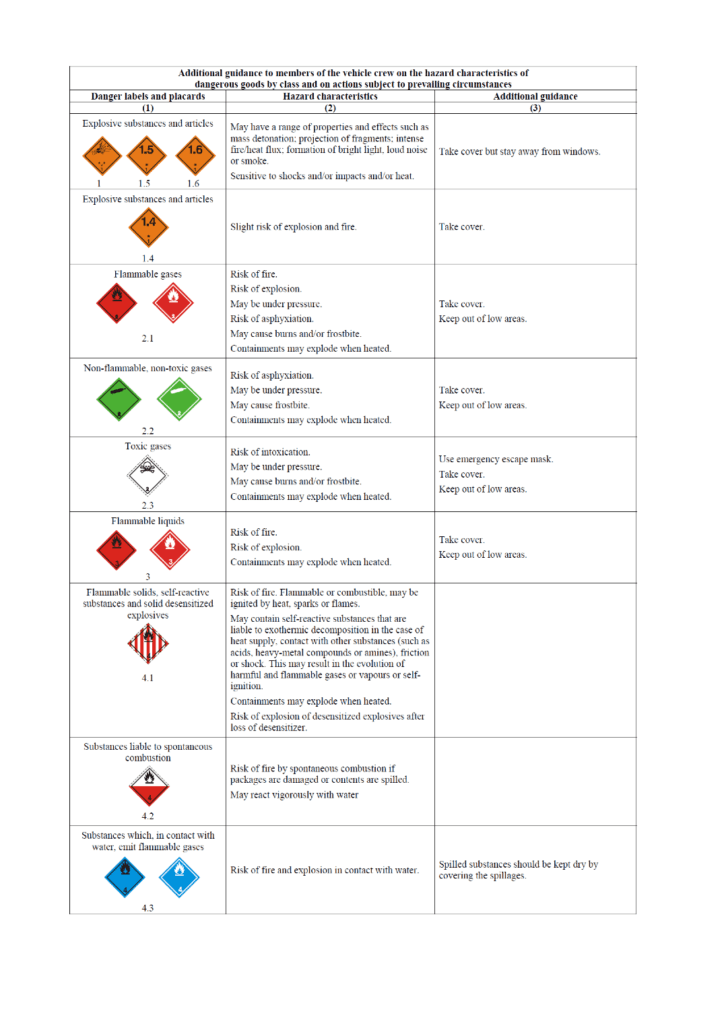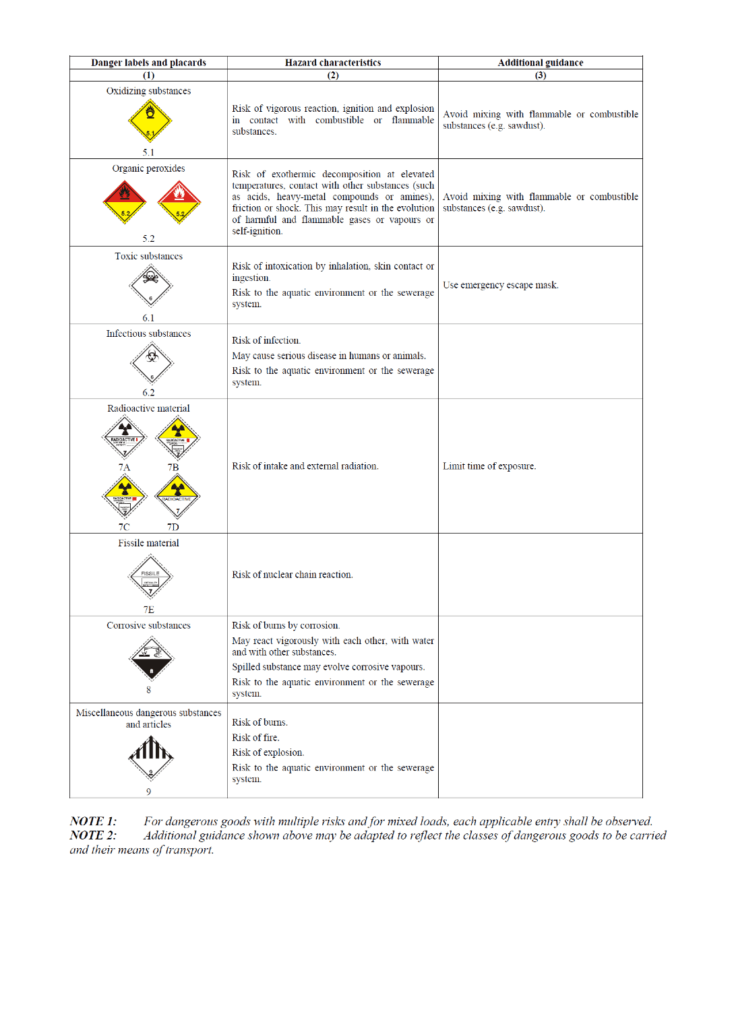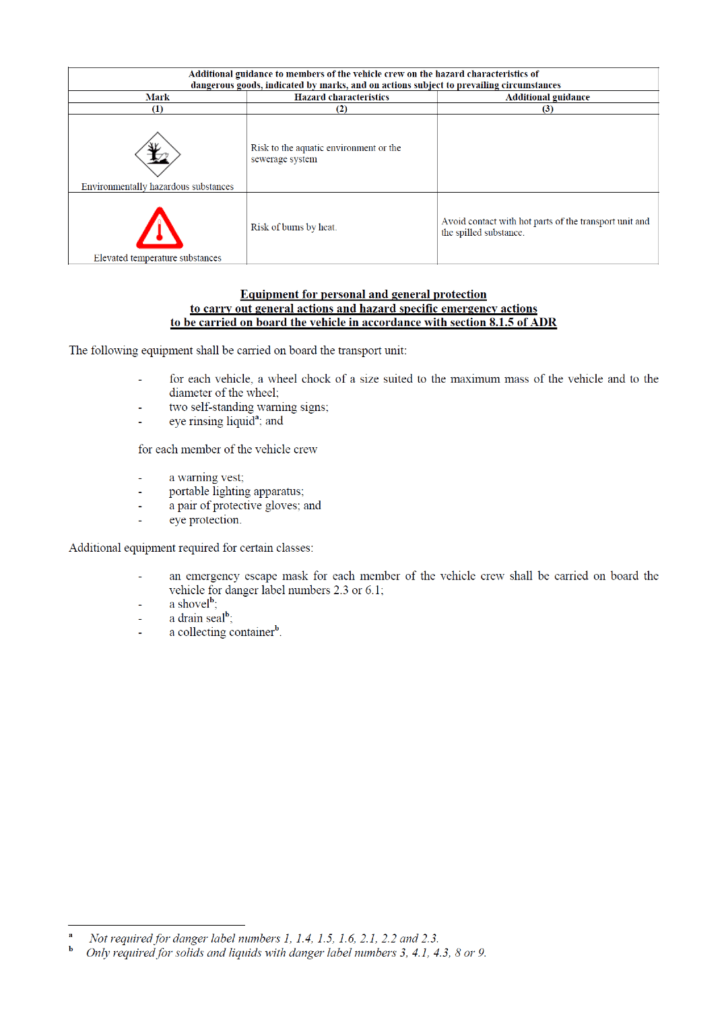Transportation
General Information
All Smoke devices and pyrotechnics regardless of the manufacturer are Class 1 Dangerous Goods (explosives) and must be packaged, marked and labelled correctly with the correct information and orange Hazard Diamond. Please see the packaging information on our website.
All smoke devices and Pyrotechnics regardless of the manufacturer must be packaged and transported correctly and legally.
Allowed Transportation
- By Courier – Use one that is approved and accepts class 1 Dangerous Goods, not all couriers will accept or can carry smoke devices and pyrotechnics.
Collection and driving yourself in a private or hired vehicle is allowed so long as the smoke devices and pyrotechnics are transported correctly. Illegal Transportation
- By Post – It is Illegal to send smokes, pyrotechnics, fireworks or any other class 1 dangerous goods through the postal system e.g. royal mail.
- By Sea and Air – It is illegal to take these types of products on a passenger ferry or on a plane.
What and how much am I allowed to transport?
Regardless of anything else written here, the Gross Weight of the vehicle (combined weight of van and cargo) must never exceed the allowed limit for that vehicle.
This information only covers the carriage of 1.4S and 1.4G smokes, Pyrotechnics and Fireworks together with other inert goods e.g. Apparel. Do not carry any other Dangerous Goods e.g. Gas, Fuel, Aerosols when transporting Smoke devices and / or Pyrotechnics.
For class 1 Dangerous Goods e.g. smoke devices, pyrotechnics and fireworks the weight limits refer to the Net Explosive Content (NEC) of the devices being transported. The NEC is the weight of the composition(s) that produces the effect e.g. bang, smoke, spray of sparks etc. All products supplied in the UK should be labelled with the NEC for that product. You may see the NEC printed on the outside of the transport packaging; this figure will be the NEC for all the products within that package.
The quantities of each hazard classification that can be carried in a vehicle within the UK are shown below for products categorised and 1.4S or 1.4G.
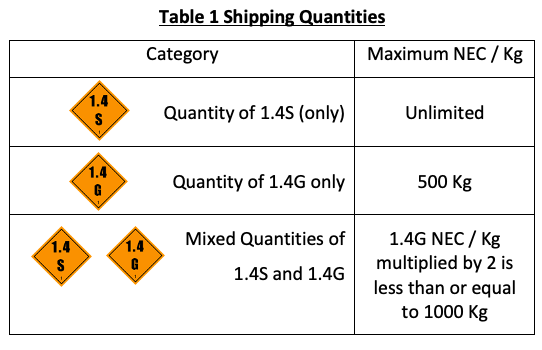
Licenses
If you are carrying smokes, pyrotechnics or fireworks with a different hazard classification or in a larger quantity than those showed in the above table, then the driver(s) of the vehicle will need to have a valid ADR license for the Class 1 Dangerous Goods.
If you are carrying smoke devices, pyrotechnics , fireworks or any other class 1 Dangerous Goods in Northern Ireland, then please check the regulations as these maybe different and additional licences or permits may be needed.
Documentation
A Dangerous Goods Note (DGN)
This document details exactly the type and quantity of Dangerous Goods being shipped, the vehicle and where they are going plus other important information. If you have multiple shipments in your vehicle you could have one DGN that covers them all or an individual DGN for each consignment. The important thing is that each consignment of Dangerous Goods is entered onto a DGN and that one or more DGN’s accurately reflect the Dangerous Goods being transported.
If the only Class 1 Dangerous Goods you are carrying are 1.4S and/or you are carrying less than 50 Kg of 1.4G, then a DGN is not required.
For road transportation the DGN (example in Annex 1) needs to include as a minimum the following information:
- Name and address of Consignor (sender)
- Name and Address of Consignee (receiver)
- For Each type of Dangerous Good:
- UN number preceded by the letters “UN”.
- Proper Shipping Name (P.S.N).
- Classification Code (1.4S / 1.4G)
- Number and description of packages e.g. 1 Box (4G) or 1 Fibreboard box.
- Total Quantity of each UN number i.e. Gross Mass, NEC and/or volume.
- Total NEC for the combined Shipment
- Tunnel Code
Instructions in Writing (Annex 2)
If you are transporting Dangerous Goods yourself, then you will also need a copy of “Instructions in Writing” in the vehicle. Instructions in writing is a simple set of general instructions that give information on what to do in the case of an emergency and pictograms to help describe to others and the emergency services, the type of goods you are carrying.
Tunnel Code
The hazard produced by Dangerous Goods trapped inside tunnels, due to vehicle breakdown or an accident could be enhanced, producing a far worse outcome than on a normal open road. For this reason, Dangerous Goods and tunnels are given a “tunnel code” in the form of the letters A -E.

Tunnels Code A: No restrictions for Dangerous Goods
Tunnels Code B: No restrictions except for goods likely to cause a large explosion.
Tunnels Code C: No restrictions except for goods likely to cause a large explosion and goods with a risk of medium explosion or large toxic gas or liquid release.
Tunnel Code D: as for C, plus restrictions for goods with a risk of a large fire.
Tunnel Code E: all regulated DG are prohibited other than UN nos. 2919, 3291, 3331, 3359 and 3373
Therefore, you can only enter a tunnel if the Tunnel code of tunnel is earlier in the alphabet than the tunnel code of the goods. For example EG products the tunnel code is “E” this means that you can enter a tunnels with codes A, B, C or D but must not enter a tunnel if it has a code “E”.
The pictures below show signs that could be present at the entrance to a tunnel or signs leading to a tunnel that indicate Dangerous Goods tunnel codes. The ones on the left shows a “C” tunnel code, its ok to enter with EG products. The ones on the right show an “E” tunnel code, Do Not Enter with EG products.
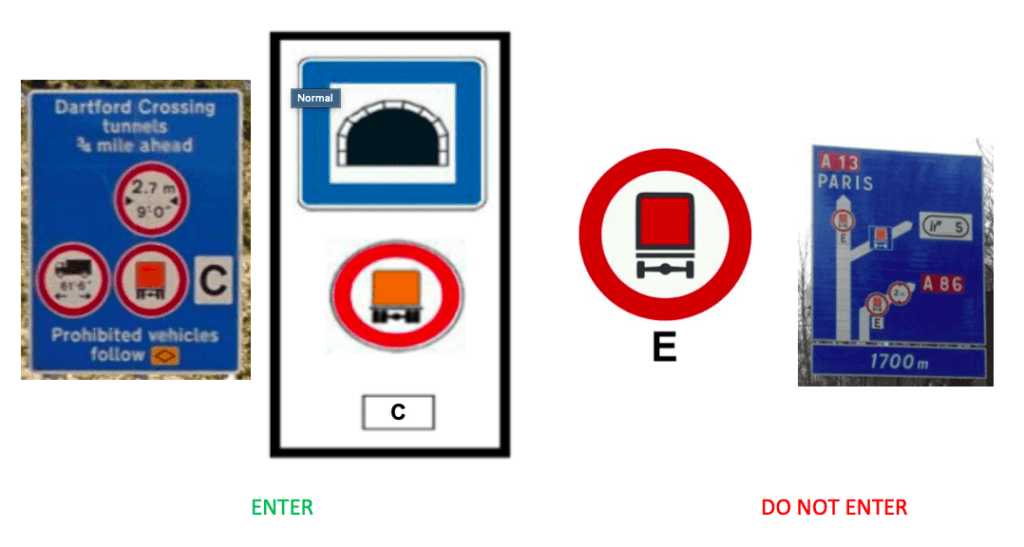
If a tunnel has no sign or tunnel code, then there are no restrictions.

Preparation of the vehicle
Before loading the vehicle and beginning any transportation involving Dangerous goods, there are a few checks that need to be carried out to ensure safety.
General Checks such as Fuel, Oil, Water, Electrics (e.g. all lights are working) and tyres should be made (see vehicle check list). In addition, the load space should be swept out and any potential causes of ignition removed or covered. Internal lighting should be checked to ensure the lighting units are covered with no exposed wiring.
You must also ensure that the vehicle is equipped with the following equipment in the case of emergency.
High Visibility Jacket – One high visibility or reflective jacket/tabard for each driver / crew member.
Fire Extinguishers – 2Kg Dry Powder extinguisher which is easily accessible and protected from various weather conditions and any spray, salt etc that can occur when driving.
The extinguisher must be fitted with a seal to tell if it has been used or not and must be inspected and bear a mark of compliance plus have a date of inspection / use by date (MM/YY).
Must always carry an ‘in date’ extinguisher.
Portable Lighting Equipment (torch or standing Lamp) – Made of either plastic or rubber and must not have any metal surface liable to produce sparks i.e. Made from ferrous (iron containing) metals. If it rusts, then it contains iron and can produce sparks. If the metal is protected by paint or a plastic / rubber case or coating thin this is ok.
Placards – When you are carrying 1.4S and 1.4G products in quantities less than those shown in Table 1, there is no need to put hazard placards on the vehicle. If you are carrying products with a greater NEC than shown in Table 1 then the vehicle needs to show the appropriate placards and the driver(s) must hold a valid ADR license.
Loading and Unloading
Vehicle Fire
Before loading or unloading ensure that the vehicle is switched off and the engine and brakes have cooled to minimise the risk of an engine or brake fire. Ensure that the fire extinguisher is readily available if such a fire were to happen.
Phones, Smoking, fire or naked flames
If you smoke or vape, you must ensure that your cigarettes, cigars, matches, lighters, vaporiser are or any other heat producing device is kept in the cab (when cab and load compartment are separated by a bulkhead), preferably in the glove compartment at all times when transporting, loading and unloading Dangerous Goods. The use of fire or naked flames and smoking or Vaping is prohibited in or in the vicinity (5m) of the vehicle during carriage or handling operations. If you, passenger, loading/unloading help or any other person needs to smoke then this must happen at least 5m downwind of the vehicle. Mobile phones and battery packs should also be kept in the cab during loading and unloading operations.
Loading
When loading, ensure that the boxes, cartons and packages are loaded evenly and in a stable way so that they do not move or fall over in transit. As far as possible it is best to load packages so that they that are spread evenly across the load area so that the walls of the load compartment securely hold the packages, it maybe necessary to secure the packages in place using straps or a cargo net.
Unloading
When unloading, be aware that by removing boxes, cartons and packages you may leave the remaining goods in an unstable way. Before continuing a journey if necessary, restack the remaining cartons and packages and re-position they are stable. It may be necessary to secure the packages in place using straps or a cargo net.
Vehicle and Cargo Supervision
When carrying more than 50Kg NEC of 1.4S or 1.4G products, vehicles shall always be supervised or alternatively may be parked, unsupervised, in a secure depot or secure factory premises.
If these facilities are not available, the vehicle, after having been properly secured, may be parked in
an isolated position meeting the requirements of (a), (b) or (c) below:
(a) A vehicle park supervised by an attendant who has been notified of the nature of the load and the whereabouts of the driver.
(b) A public or private vehicle park where the vehicle is not likely to suffer damage from other vehicles, we include hotel carparks, multi-storey car parks or similar (does not include on street parking); or
(c) A suitable open space separated from the public highway and from dwellings, where the public does not normally pass or assemble. We include the lorry parking area of a service station or an isolated area away from the road at a roadside rest stop in Europe.
The driver, emergency services and the competent authorities must be notified in the event of loss or fire.
The above supervision rules need not be followed if the vehicle is parked within a safe and secure place.
Emergency Procedures
When there is an immediate risk that public safety may be jeopardized, the emergency services should be immediately notified, all information must be given to them so that they can take appropriate action.
Actions in the event of an accident or in an emergency
- Stop the vehicle in a safe location preferably off the carriage way and away from built up areas. Where possible isolate the battery.
- Avoid sources of ignition, do not smoke, use electronic cigarettes or similar devices or switch on any electrical equipment.
- Inform the appropriate emergency services, giving as much information about the incident or accident and substances involved as possible.
- Put on the high-vis jacket / vest and place the self-standing warning signs as appropriate.
- Keep the transport documents readily available for responders on arrival.
- Do not walk into or touch spilled substances and avoid inhalation of fumes, smoke, dusts and vapours by staying up wind.
- Where appropriate and safe to do so, use the fire extinguishers to put out small/initial fires in tyres, brakes and engine compartments and any small grass fires in the vicinity.
- Do not tackle fires in load compartments.
- Where appropriate and safe to do so, use on-board equipment to prevent leakages into the aquatic environment or the sewage system and to contain spillages.
- Move away from the vicinity of the accident or emergency, advise other persons to move away and follow the advice of the emergency services.
- Remove any contaminated clothing and used contaminated protective equipment and dispose of it safely.
- Inform the office.
Summary
- Ensure that the Dangerous Goods you are carrying are properly classified and Authorised by HSE.
- Ensure you are within the weight limits for the vehicle and for the explosives you are carrying.
- Check you are not carrying gas and fuel or other dangerous goods in the same vehicle as the explosives.
- Ensure all packages are properly marked and labelled.
- You have the correct documentation and its accurate.
- The vehicle is in good working order and you have the necessary equipment
- The goods are loaded evenly and are secure.
- Cigarettes, lighters, phones and other flammable or electronic equipment is in a separate area to the explosives; either in the cab if there is a bulkhead or in the glove box.
Further Information
The shipping / carrying or transporting Dangerous Goods in UK is covered by the “Carriage of Dangerous Goods: Approved Derogations and Transitional Provisions United Kingdom April 2012” regulations.
HSE Explosives Website
Annex 1 – Transport information for EG products.

Annex 2 – Instructions in Writing
